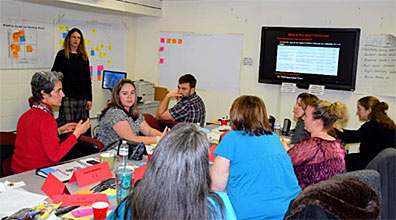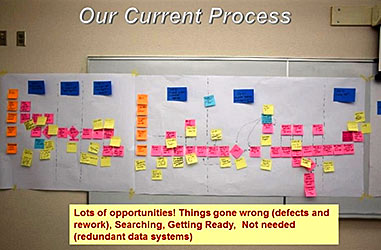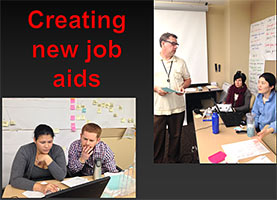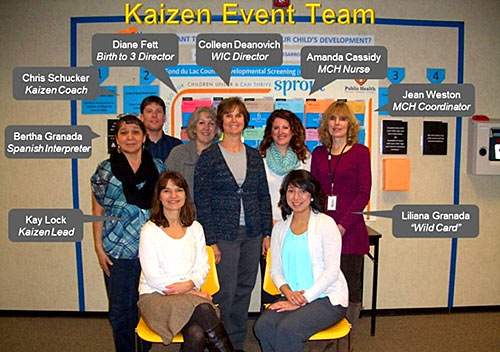News and Events
NACCHO 2015 Model Practices Award Application Now OpenTuesday, October 7, 2014 - NACCHO is accepting applications for the Model Practices Awards through Oct. 31. NACCHO's Model Practices Program honors outstanding local public health practices and shares them through the Model Practices Database. Click here to learn more. |
 |
Kaizen Article 3 of 4: PeopleMonday, September 29, 2014 - The heart, mind, soul, and muscle of your health department: your people! Written by PHQIX Expert Panel member Chris Bujak and his business partner Pam Vecellio, of Continual Impact LLC. Visit the Ask an Expert page for more advice from PHQIX Expert Panelists. The COPPHI Kaizen Event Program recently completed foundational QI and Kaizen training, coaching, and co-application of kaizen events at 10 health departments. The program was funded by the Robert Wood Johnson Foundation (RWJF), and managed by National Network of Public Health Institutes (NNPHI), with the training and expertise provided by Continual Impact LLC. Keys to successful Kaizen events and to creating a culture of high performance are the involvement, knowledge, actions and ownership of the individuals performing the work process. A Kaizen event helps to unlock the capacity of the people in your organization! Kaizen simply means “change for the better”. A kaizen event is a team-based approach that enables improvement to be made by stepping through all phases of the improvement cycle in an effective and rapid fashion. Before the event, a kaizen-appropriate problem is identified along with goals in areas such as customer satisfaction, cycle time and labor reduction, and error elimination. The team is then mobilized and a kaizen event begins. A typical event uses a systematic process to identify waste in the targeted work process, enable the team to understand and analyze the root causes, identify and test solutions, learn, install improvements, and create a system for ongoing improvement. As the event progresses, numerous QI and change management methods and techniques are applied. The event enables the team to accomplish all this work quickly, typically in 5 days with full benefits achieved within 1-3 months!
…and what did the team members have to say about the experience? “Going from current to future state blew my mind – you have to experience it.” “It is nice to see how proud people are and how they own these improvements and new process.” “This kaizen event was a roller coaster—after I got off, I’m ready to do it again!” “We dealt with a lot of personalities; emotionally trying but very successful.” One particular team commented on their progress: From: “We’ve never been asked our opinion before, we’re just told what to do,” “I have much more capability than people realize but feel looked down on because I’m just an operator,” “you’re just trying to get us to do more work,” “we expect when all this is done you will tell us we don’t have a job”. To: “ In the end we got hugs from everyone, and they made comments like it turned out right like you told us on Monday,” “Sorry I was mean to you,” and “We’re sorry you are leaving.” “We ended up receiving positive feedback from everyone. Of course in 1 week it did not eliminate issues completely, but it was a powerful example of kaizen’s ability to generate positive energy in people!” Other organizations with compelling “Team stories” during their Kaizen events can be found below:
Untreated chlamydia (CT) and gonorrhea (GC) can lead to serious health problems in men and women. In order to effectively track and treat these two sexually transmitted infections, CDC guidelines require that low-priority CT and GC reports be processed by health departments within 30 days of receiving a reporting form from a laboratory or medical provider office. The Chicago health department had been experiencing a large backlog of these reports, and used a kaizen event and PDCA approach to dramatically reduce the processing and backlog time in order to improve the surveillance and control of these infections. |
 |
QI Innovator Award Winner - Wanda Williams, LSSBBTuesday, September 23, 2014 - It is our pleasure to honor Wanda Williams, from the Tacoma-Pierce County Health Department in Washington State, as a public health QI Innovator. Congratulations, Wanda! What makes Wanda Williams a QI Innovator?
We asked Wanda to share some insights regarding challenges encountered, lessons learned, and advice about public health QI. Here's what she had to say! Q: Describe one challenge you have encountered in conducting QI in public health and how you worked to overcome that challenge. A: One challenge I have encountered in conducting QI in public health is buy-in—buy-in at all levels, from leadership to the front lines. I would say this is a constant challenge and is overcome through consistent, sometimes persistent, demonstration of value. The easiest way to demonstrate the value is through a project effort that removes pain points or improves efficiency and effectiveness or saves millions of dollars. However, not all projects end up being knock-it-out-of-the-park successes. The value then comes in staff better understanding their role, their work processes and how they contribute to the overall mission and vision of their program and agency. My approach to getting buy-in is to teach, build, share and support. I provide my teams with knowledge, share tools and tips to help build their understanding and confidence, acknowledge and share their successes and lessons learned and support them in continual learning and improvement. I think my work is like tossing a pebble in the lake. Each communication, training, action and project creates a ripple. One toss will not sustain the effort. My hope is to spread and share knowledge, understanding and skill within each circle of influence which builds ownership and momentum. Through learning, doing and sharing, everyone creates their own ripple to spread and create a culture of quality improvement. Q: What is one key lesson you have learned in your experience implementing public health QI initiatives? A: There are so many lessons to learn. If I was to only share one, it would be to not take things personally. No matter how passionate, enthusiastic, supportive or encouraging you may intend to be, the impact of your efforts will inevitably rub someone the wrong way. Change is hard. Learning and growing can be a challenge as well. To keep it all in perspective, remember quality is a journey. We each take it at a different pace, perspective and understanding. Just dust yourself off, smile and keep moving forward. Somewhere along the way, the ripple will touch someone in a positive way. Q: What advice would you give to public health practitioners who are new to QI? A: My advice to newbies—enjoy it! Look at quality improvement as an ongoing adventure. You will discover new things about yourself and those you work with. You will discover passionate, creative, innovative and hardworking individuals that truly want to provide the best products and services to their customers and to be the best in what they do. This passion and drive will help fortify you when barriers, conflict, and failure come your way. Just fail forward—there is always something to learn in every improvement effort. Congratulations, Wanda! Thank you for sharing these wonderful insights, for your demonstrated leadership in public health QI, and for being a member of the PHQIX community! |
|
NACCHO Resource: Integrating Performance Improvement ProcessesWednesday, September 17, 2014 - The National Association of County & City Health Officials (NACCHO) released a document that explores the connections among several performance improvement processes and standards, including Mobilizing for Action through Planning and Partnerships (MAPP), the National Public Health Performance Standards Program, and the Public Health Accreditation Board accreditation. Click here to learn more. |
 |
Kaizen Article 2 of 4: Who are your customers?Wednesday, September 10, 2014 - Who are your customers? How can you better satisfy their expectations? Written by PHQIX Expert Panel member Chris Bujak and his business partner Pam Vecellio, of Continual Impact LLC. Visit the Ask an Expert page for more advice from PHQIX Expert Panelists. The COPPHI Kaizen Event Program recently completed foundational QI and kaizen training, coaching, and co-application of kaizen events at 10 health departments. The program was funded by the Robert Wood Johnson Foundation (RWJF), and managed by National Network of Public Health Institutes (NNPHI); training and expertise were provided by Continual Impact LLC. Four of these kaizen events focused on customer relations and improving satisfaction. Kaizen is simply a term that means “change for the better”. A kaizen event is a team-based approach that enables improvement to be made by stepping through all phases of the improvement cycle effectively and rapidly. Before the event, a kaizen-appropriate problem is identified along with goals in areas such as customer satisfaction, cycle time and labor reduction, and error elimination. The team is then mobilized and a kaizen event begins. A typical event uses a systematic process to identify waste in the targeted work process, enable the team to understand and analyze the root causes, identify and test solutions, learn, install improvements, and create a system for ongoing improvement. As the event progresses, numerous QI and change management methods and techniques are applied. The event enables the team to accomplish all this work quickly, typically in 5 days with full benefits achieved within 1-3 months! Team members commented: “Did not realize before the waste in our processes—we do now.” “This was a rollercoaster—after I got off, I wanted to go again.” “Learned how we are going to improve our processes.” “We exceeded our goal through our kaizen!” “Wealth of information that we can apply to our lives.” El Dorado County Health and Human Services Agency improved their customer satisfaction and reduced labor time in the county “Request for Information” process. The team used a kaizen event to understand the problem, identify issues and waste, identify root causes of the issues, and then develop, test, and begin installing the solutions in 1 week. To achieve the improvements, the team created a list of information subject matter experts, standardized work for answering phone requests, developed a live transfer process and internal service-level agreements for returning customer calls; added key information to the county website for self-service, and clarified and simplified the phone tree. Customers can now get their needed information faster and at less labor cost by the team!
Other organizations that targeted customer improvements during their kaizen events can be found below:Washington County Public Health Division conducted their kaizen event to improve the volume of childcare facilities that used the LHD for their state required inspections. This improvement work was completed in a one-week intensive improvement effort and resulted in: (1) implementation of a scheduling and preparedness call by the Environmental Health Specialist (EHS), (2) introduction of service standards for scheduling, (3) elimination of a redundant log and data entry system, (4) creation of standardized work and job aids, (5) creation of policies and protocols for areas in which ambiguity exists, and (6) introduction of a protocol to set a 5-day calendar window with the customer for inspection as part of the scheduling and preparedness call done by the EHS.
Clackamas County Public Health Division conducted their kaizen event to design and implement a customer feedback system for the entire public health division. The process and tools used for the project are well described and easy to adapt by other health departments. While Clackamas has not yet achieved their targets for the improvement, they increased completed client feedback forms from 8 to 21 per month, and the lessons learned while conducting the project and the examples of tools and methods makes this project well worth reviewing.
The Fond du Lac County Health Department increased the number of children being screened for developmental delays from 5 to 9 per month, allowing more children to be appropriately connected with services to enhance their early childhood development through early intervention and minimize potential developmental delays.
|
 |
QI Tips for Creating Culturally Sensitive MaterialsFriday, September 5, 2014 - Creating culturally sensitive materials is increasingly important as the U.S. sees an increase in the number of residents speaking languages other than English at home. The National Institute for Children's Health Quality (NICHQ) recently published some tips for creating culturally sensitive patient materials that also apply to creating communication materials for public health programs. Click here to read the full article. |
 |
NICHQ Webinar: Tips for Engaging Leaders in QI WorkTuesday, August 26, 2014 - The National Institute for Children's Health Quality (NICHQ) is conducting a free webinar about how to effectively engage leadership in quality improvement work on Tuesday, September 16, 2014, from 1:30-2:30 p.m. EDT. This webinar will present tips for engaging leaders in the clinical, public health, and community sectors. Click here to register! |
 |
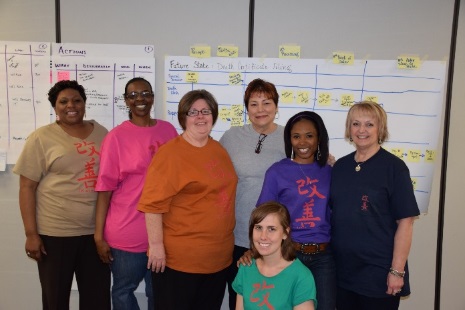 DeKalb County Board of Health’s kaizen event
DeKalb County Board of Health’s kaizen event 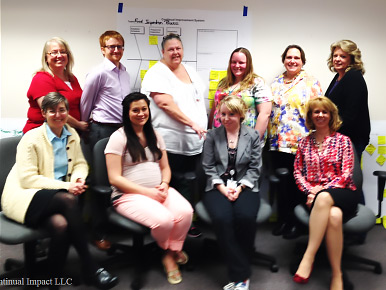 Kaizen events lend themselves to rapid improvements in routine health department processes. Tazewell County Health Department utilized Kaizen tools to full advantage--
Kaizen events lend themselves to rapid improvements in routine health department processes. Tazewell County Health Department utilized Kaizen tools to full advantage-- The staff was able to reduce the backlog time of low-priority CT and GC reports, receipt to closure in INEDSS, from 86 days to 30 days and anticipate further improvement. he STI Surveillance Program immediately changed the method for how incoming reports were sorted and bundled for assignment to data entry staff; developed a revised morbidity reporting form and standardized laboratory reporting form to reduce data entry time; and determined that data entry staff was keeping up with incoming reports and the backlog was perpetuated year after year and proposed a solution to management so that the backlog could be permanently addressed. Additional outcome was improved staff morale!
The staff was able to reduce the backlog time of low-priority CT and GC reports, receipt to closure in INEDSS, from 86 days to 30 days and anticipate further improvement. he STI Surveillance Program immediately changed the method for how incoming reports were sorted and bundled for assignment to data entry staff; developed a revised morbidity reporting form and standardized laboratory reporting form to reduce data entry time; and determined that data entry staff was keeping up with incoming reports and the backlog was perpetuated year after year and proposed a solution to management so that the backlog could be permanently addressed. Additional outcome was improved staff morale!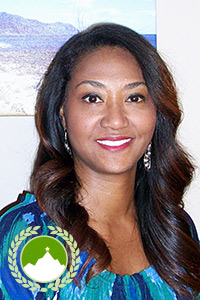 Wanda Williams, Quality Management Consultant of the Tacoma-Pierce County Health Department in Washington State, has helped to build a quality improvement (QI) culture by leading and guiding other staff, both within and outside of her department. For the past 6 months, she has led a creative and innovative approach to bringing quality to the department’s Sexually Transmitted Disease (STD)/HIV program by facilitating multiple Kaizen workshops. Always respectful of individual staff members’ needs and work styles, Wanda empowers the STD/HIV program team members to make improvements on their own, and she shines the spotlight on their successes.
Wanda Williams, Quality Management Consultant of the Tacoma-Pierce County Health Department in Washington State, has helped to build a quality improvement (QI) culture by leading and guiding other staff, both within and outside of her department. For the past 6 months, she has led a creative and innovative approach to bringing quality to the department’s Sexually Transmitted Disease (STD)/HIV program by facilitating multiple Kaizen workshops. Always respectful of individual staff members’ needs and work styles, Wanda empowers the STD/HIV program team members to make improvements on their own, and she shines the spotlight on their successes. 